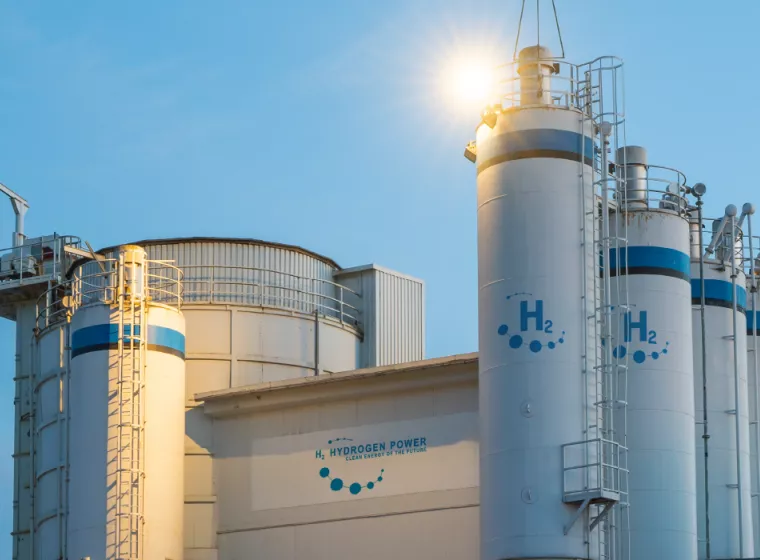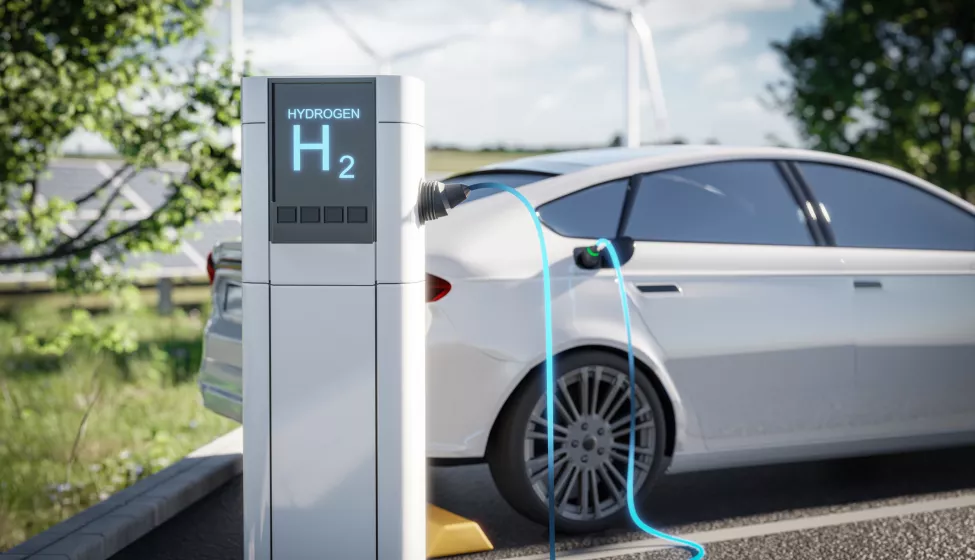August 30, 2024

How hydrogen fuel cells could help expand electric vehicle charging networks
The Environmental Protection Agency's new auto emissions standards aim to cut carbon dioxide emissions from passenger cars by nearly 50% compared to existing standards by 2032. These standards are designed to encourage a majority shift toward electric vehicles and improve public health and air quality.
Despite a recent slowing in EV adoption rates in the U.S., sales still increased 60% overall from 2022 to 2023. However, as more people purchase and drive EVs, the demand for fast charging infrastructure continues to rise in parallel. Given recent developments, like Tesla's decision to downscale the expansion of its battery electric vehicle (BEV) charging network, questions about how charging infrastructure will continue to meet public demand — and the need to explore alternative opportunities — are central to the goal of scaling EVs in the long run.
As a carbon-free fuel, hydrogen has long been projected to play a lead role in a more sustainable future. It's currently used to power hydrogen fuel cell electric vehicles (FCEVs), and it's being tested for use in long-distance semi-trucks, trains, aircraft, and shipping applications. Hydrogen can also be used as an alternative fuel source for charging EVs.
Several companies are now exploring EV charging with hydrogen, typically representing partnerships between energy stakeholders and OEMs, with a variety of deployments anticipated between now and 2026. Most development in this space is in the pilot stage, and some entities have missed their proposed launch dates, underscoring the technical challenges of bringing this high-potential application to market.
Hydrogen fuel cells for EV charging
Hydrogen fuel cells react hydrogen with oxygen to produce electricity. The only byproduct is water, which is what makes hydrogen such an attractive alternative fuel source. Hydrogen fuel cells have been used in aerospace and military applications for decades and in commercial passenger vehicles for nearly 20 years.
In these cases, hydrogen fuel is carried onboard, typically compressed in tanks. Automakers have mass produced several hydrogen fuel cell EV models, which compete with other alternative fuel vehicles such as battery electric models. Regardless of hydrogen's role in the light-duty automotive industry, it holds strong promise as a viable zero-carbon fuel for other applications, with substantial projected long-term growth.
To use hydrogen fuel cells for EV charging, hydrogen can be produced via electrolysis from water using excess renewable energy like solar or wind and then used on site in a fuel cell to generate the electricity needed to charge EVs. There are several advantages to using hydrogen fuel cells for this purpose:
- Independent operation — Hydrogen fuel cells offer a compelling alternative to traditional electric grids for powering EV charging stations, especially in remote areas. This technology can operate independently from the electrical grid by generating electricity directly at its point of use; it's particularly advantageous in locations where extending the traditional power grid is impractical or cost prohibitive. These proposed hydrogen charging stations could also help ease "range anxiety" for EV owners and potential buyers who may view EVs as impractical for their driving needs.
- Scalability and flexibility — Hydrogen fuel cells are inherently scalable. They can be modularly expanded to meet increasing energy demands without the extensive infrastructure required for grid expansions. This makes them ideal for growing networks of EV charging stations, where they can adapt seamlessly to varying energy requirements.
- Rapid deployment and mobility — Hydrogen can be stored and transported in trucks for the quick establishment of fuel-cell-based charging stations. These can be deployed rapidly and relocated as needed, providing a flexible approach to the geographic and temporal shifts in EV usage patterns.
- Dual compatibility — Stations equipped with hydrogen fuel cells can serve both BEVs and FCEVs, creating a unified refueling infrastructure. This dual compatibility could streamline operations and enhance the user experience by providing a single stop for different types of EVs.
- Environmental impact — Hydrogen fuel cells can produce electricity with only water and heat as byproducts, offering a zero-emissions solution that aligns with global carbon reduction goals.
Hydrogen safety considerations
There are many benefits of using hydrogen fuel cells for EV charging, but there are also many safety challenges to consider. Hydrogen is highly flammable, volatile, and difficult to store efficiently. To make hydrogen fuel cell EV charging a reality, energy companies and OEMs will have to navigate these safety issues.
Transportation and storage: Transporting hydrogen requires robust safety protocols to prevent leaks and explosions. Despite recent efforts, the infrastructure for hydrogen transport and storage is still underdeveloped compared to other fuels. Understanding the protocols surrounding hazardous substances and leveraging engineering expertise for the safe — and economically viable — transport of hydrogen is critical in minimizing risk. For example, the following strategies can help mitigate ignition risks:
- Leak and ignition detection — Operators can employ chemical or optical sensors to detect leaks or heat or optical sensors to quickly detect ignition and deploy fire suppression systems that help reduce or prevent fires and explosions.
- Emergency shutdown systems — Leak and ignition detection sensors can be linked to emergency shutdown systems to stop the flow of hydrogen within seconds. Rigorous training on emergency procedures for personnel and understanding of typical protocols and points of risk are essential to human safety.
- Regular maintenance safety checks — Hydrogen is often stored under pressures up to 10,000 psi, making the condition and maintenance of storage vessels and transportation pipelines extremely important. Operators can thoroughly check the condition of storage vessels, valves, and pipelines to minimize the chances of leaks.
Site planning: If not managed correctly, the co-location of hydrogen fueling stations and EV charging facilities introduces the potential for fires or explosions. For this new application, in-depth understanding of current hydrogen uses, best practices, and knowledge of various systems and the implications of leaks and vulnerabilities is essential to the development of a public-use platform. This could be even more important if hydrogen EV charging is to take off in remote or off-grid locations, where vegetation, forestation, and the potential lack of immediate emergency services could escalate the possibility of fire. To minimize the risks of positioning compressed hydrogen near high-voltage EV chargers, operators can take the following steps:
- Include adequate setbacks — Operators can locate hydrogen infrastructure away from surrounding foliage and other potentially flammable materials. Setbacks provide a buffer between hydrogen equipment and the surrounding areas.
- Separate equipment — Hydrogen storage or manufacturing equipment (like electrolyzers) and fuel cells can be located at a safe distance from EV charging infrastructure. This may require additional high-voltage cabling but can reduce the risk of EV chargers igniting airborne hydrogen.
- Build automatic safety systems — Fire suppression systems and automatic shutoff equipment can greatly minimize the risks of hydrogen ignition. While expensive, automated systems that detect leaks or fires can prevent costly damage.
Other hydrogen fuel cell charging challenges
- Cost and infrastructure — While hydrogen fuel cells are efficient, the initial setup and ongoing operational costs can be higher than traditional electrical grid-connected stations. This includes costs associated with producing, storing, and transporting hydrogen. Hydrogen fuel cells also require different maintenance procedures than other fuel stations.
- Regulatory and Certification Challenges — Deploying hydrogen fuel cells for public use requires navigating an evolving landscape of regulations and standards. Equipment must be certified for hydrogen use, and operators will need to establish emergency response strategies that are specific to hydrogen technologies; however, given the state of maturity of hydrogen in the market, existing regulations and standards may not cover all scenarios. Stakeholders can benefit from thinking holistically about requirements for other flammable/hazardous substances across the energy sector and developing an approach that addresses the specificities of a new EV charging station or facility accordingly.
Hydrogen: A piece of the zero-carbon puzzle
The integration of hydrogen fuel cells into EV charging infrastructure presents a promising path forward in the quest for a sustainable and resilient energy future. Despite challenges and safety considerations, the benefits — including environmental impact, scalability, flexibility, and off-grid capabilities — position hydrogen as a critical component of future energy strategies.
As hydrogen fuel cell technologies advance, with many still in the research and development phase, collaboration between scientists, engineers, industry leaders, and policymakers is imperative. A balanced approach can help ensure that the transition to hydrogen not only supports the growth of EVs but also aligns with broader environmental and economic objectives. Embracing hydrogen fuel cells as a complementary solution to traditional charging infrastructure could better support the adoption of EVs, helping progress zero-emissions commitments and a more sustainable, resilient, and carbon-neutral future.
What Can We Help You Solve?
Exponent's multidisciplinary technical and regulatory experts help clients understand the opportunities and risks of new hydrogen applications, including the challenges facing blue and green hydrogen production; flammability and toxicity issues; financial disclosures for hydrogen conversions; and the technical implications of capturing, sequestering, or using carbon dioxide for blue hydrogen production.

Hydrogen Systems & Fuel Cell Technologies
Innovate with new hydrogen technologies and solve challenges with electrolyzers, fuel cells, liquefaction technologies, and ammonia conversion systems.

Sustainability
Meet changing sustainability regulations with rigorous science and experienced consulting services.

Power & Energy
Multidisciplinary support for high-power energy systems of all sizes in a variety of applications.

Pipeline & Process Piping
Mechanical engineering expertise for pipeline construction, pipe corrosion, pipeline integrity management, and pipeline failure analysis.
![Chemical Engineering [TS]](/sites/default/files/styles/cards_home_card/public/media/images/GettyImages-1219894397.jpg.webp?itok=vB6wWXxH)
Chemical & Biochemical Engineering
Occupational safety and equipment evaluations, risk assessments, accident investigations, and data modeling for profitable practices.

Process Safety Hazards & Risk Analysis
Thermal science expertise to help you Identify hazards, mitigate risks, and improve safety and compliance with regulatory practices





